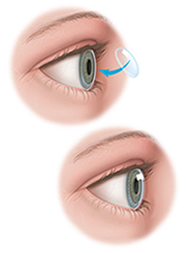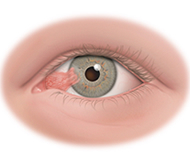Cornea
Corneal Transplant

At Westwood Ophthalmology, full thickness corneal transplants (penetrating keratoplasty) as well as partial thickness corneal transplants (Descemet’s stripping endothelial keratoplasty and anterior lamellar keratoplasty) are performed depending on the eye condition. The main benefits of partial corneal transplant are that visual recovery is faster and uncorrected vision tends to be better. The type of transplant that would work best will depend on the eye condition.
The surgery is a same-day procedure that takes approximately one to two hours. Most corneal transplants are performed with light sedation, but general anesthesia can also be utilized depending on the situation. An eye patch is used to protect the eye after surgery overnight, but removed the following day. Visual recovery is longer than with other eye surgeries such as cataract surgery. Call our office located in Bergen County, NJ to have our corneal specialist evaluate your condition to determine what procedure is best suited for you.
Descemet Membrane Endothelial Keratoplasty
DMEK surgery is a partial corneal transplant surgery which involves removing the patient’s inner corneal lining that contains failing endothelial cells. This is replaced with the donor’s endothelial cells and Descemt’s membrane. During the surgery, an air bubble is placed into the eye to tamponade the corneal transplant graft onto the patient’s cornea. The air bubble remains in the eye for approximately 5 days which is enough time for the graft to naturally adhere to the patient’s cornea. During the first 2-3 days it is imperative for the patient to lay flat on their back for most of the day to prevent dislocation of the graft. Prior to the surgery, a laser iridotomy is performed in the office to prepare the eye for the DMEK surgery.
Descemet's Stripping Endothelial Keratoplasty
DSEK surgery is another type of partial corneal transplant which is similar to DMEK but the main difference is that the donor tissue is thicker than that of DMEK. This procedure is generally performed in eyes with more complex history such as prior vitrectomy, glaucoma tube, large iris defects and anterior chamber intraocular lens. An air bubble is also required for this surgery and patients are required to lay flat on their back for 1-2 days after the surgery.
Penetrating Keratoplasty
For certain patients, a full thickness corneal transplant may be required to treat the patient’s corneal condition. In this surgery, all of the layers of the diseased cornea are removed and replaced with a donor cornea. Approximately 16 sutures are placed to secure the graft which are removed after waiting 6-12 months from the surgical date. Due to the more invasive nature of this surgery, the healing process is longer than that of partial corneal transplant surgery. Glasses and/or contact lenses are often necessary to correct vision to an acceptable level due to post surgical astigmatism.
Deep Anterior Lamellar Keratoplasty
DALK is selective removal of the patient’s anterior portion of the cornea and replaced with the donor's anterior cornea. Approximately 16 sutures are inserted to stabilize the corneal transplant which are later excised after 4-6months. The native endothelial cells and Descemet’s membrane are left in place so the chance of graft rejection is low and the structural integrity of the eye is stronger than that of penetrating keratoplasty.
Dry Eye Syndrome
Dry eye syndrome is a very common condition in which tears are not able to adequately lubricate the eyes. Symptoms are numerous but the most common are foreign body sensation, redness, irritation, burning, sandy sensation, tearing, blurred vision, eye fatigue, light sensitivity, etc. It is usually caused by either an inadequate amount of tears or by tear instability. The tear instability is usually caused by meibomian gland dysfunction which essentially is a blockage of the glands within the eyelids.
Treatment of dry eye syndrome include over-the-counter artificial tear eye drops, prescription eye drops such as restasis and xiidra, punctal plugs, warm compresses, Avenova eyelid cleanser, eyelid scrubs, omega 3 supplements, autologous serum tears and Lipiflow.
Lipiflow
Lipiflow is a treatment option for meibomian gland dysfunction to improve gland blockage and symptoms of dry eye syndrome. Once a Lipiscan test confirms blockage of the meibomian glands, a 12 minute in-office procedure is completed which effectively treats the gland blockage by heat and compression. Topical anesthetic eye drops are placed into the eye then activators are inserted which connect to the Lipiflow machine. The machine then heats the eyelids and gently massages the eyelids over 12 minutes. Maximum treatment benefits are reached within 6-8 weeks. Warm compresses are strongly recommended at home after Lipiflow treatment which can be repeated if necessary once or twice per year.
Pterygium

Treatment involves eyedrops to lubricate the eye as well as limiting sun exposure. If symptoms are bothersome then surgery can be performed to remove the pterygium. At Westwood Ophthalmology, a no-stitch procedure is performed in which the abnormal tissue is excised and a conjunctival autograft is placed to reduce the chance of recurrence as well as to minimize post-operative discomfort. Post-operative drops are used to prevent infection and to help with the healing process.

Connect With Us